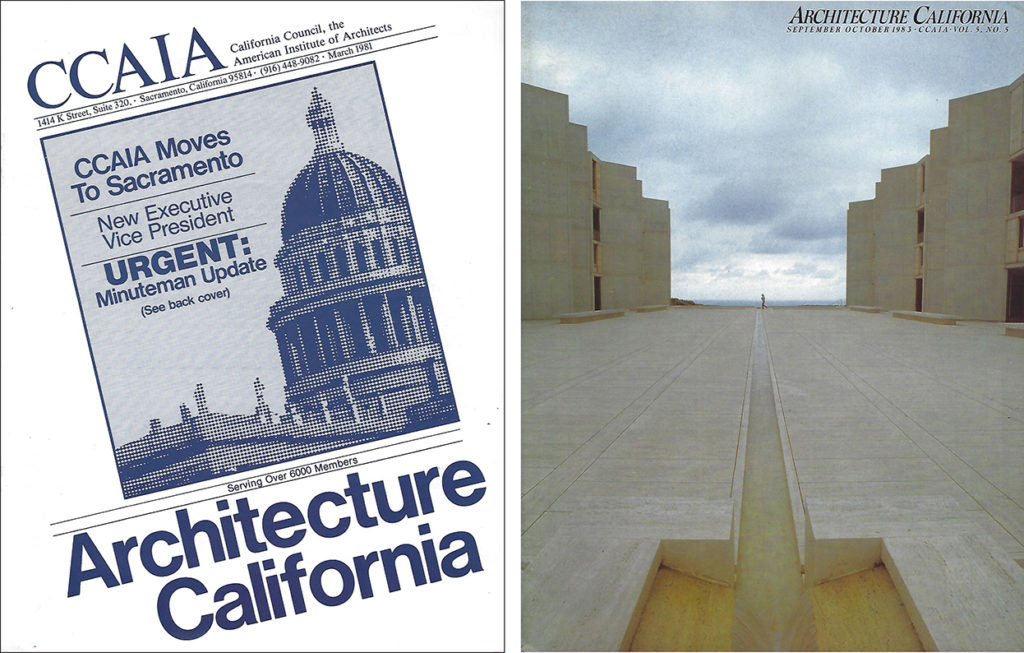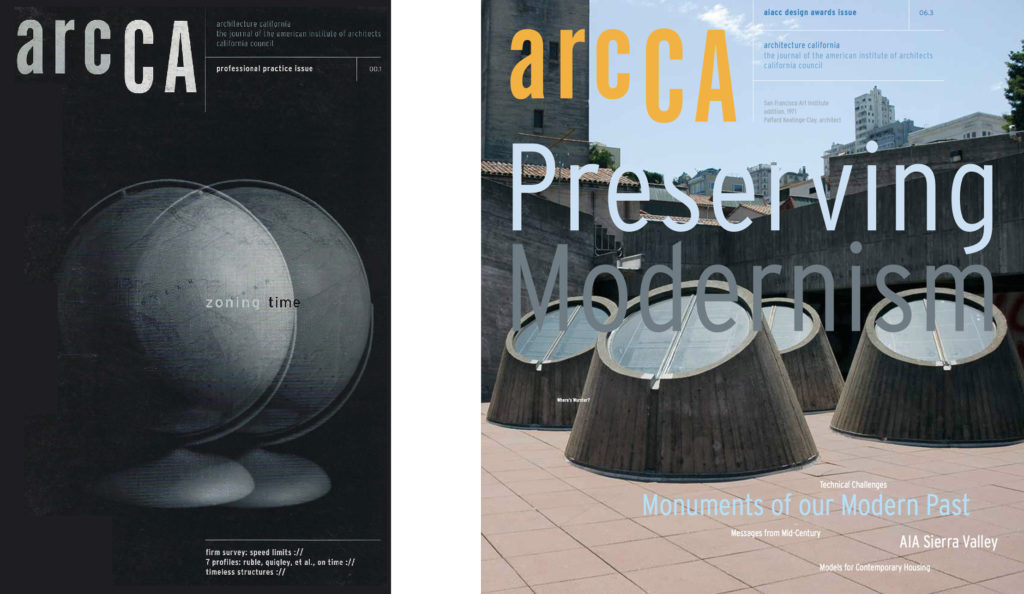arcCA DIGEST is the online successor to arcCA (Architecture California), the former print journal of AIA California—itself formerly known as AIA California Council (AIACC) and, before that, as California Council AIA (CCAIA). This season of arcCA DIGEST presents and celebrates the complete print archive of arcCA, now fully available online.
Architecture California was first published in 1979 and began publishing regularly in 1981, with CCAIA’s move from San Francisco to Sacramento and the appointment of a new executive director, Paul W. Welch, Jr. For its first decade, it was an 8.5” x 11”, saddle-stitched, mostly bi-monthly production, comprising both feature articles and component news.

In 1990, in the face of a significant budget cut, an editorial board composed of Barton Phelps, FAIA (Chair), Joseph Esherick, FAIA, and William Turnbull, FAIA, with Orlando Maione, AIA, Vice President of Communications, ex officio, reshaped the journal, eliminating news and advertising, which had become an economic drain, rather than a revenue source. The goal, as Phelps put it, was to “produce a meatier, better written, more informative magazine at less expense.” For this purpose, The Dunlavey Studio designed an elegantly frugal, 6” x 9”, perfect-bound format.

Martin’s reflections appear in his outgoing editor’s introduction to the first edition of arcCA, the journal’s third manifestation, conceived under the leadership of Editorial Board Chair Carol Shen, FAIA. In his introduction, Martin writes,
As the journal moves into a new era, it is important to remember some of the factors that brought it to this point. The vision of Esherick, Turnbull and Phelps gave life to the material. That vision positioned Architecture California as not just another trade magazine but a fully refereed scholarly journal. For six years, through the work of editor Lian Hurst Mann, the journal earned local and regional acclaim as well as national recognition. In her words, “Each edition of Architecture California has become a kind of chapbook of primary writings on a particular topic, with many points of view, including those that can contribute to the field for years to come.”
The transformation from Architecture California to arcCA was also driven by financial pressure. To make the journal self-sustaining, there would again be advertising, but now it would be sold by AIACC’s new publishing partner, McGraw-Hill Construction. arcCA began in 2000 in a 7” x 10”, duotone, perfect-bound format, designed by Bob Aufuldish of Aufuldish + Wariner. In 2006, a change from sheet-fed to continuous roll printing allowed the format to expand to 9” x 10” and made full-color affordable.

arcCA’s goal was to illuminate the context within which California architects practice, and this context was broadly conceived. For example, recognizing that California architects were practicing in many parts of the world, “Global Practice” (2nd quarter 2003) invited architects from thirteen nations to describe how practice is conducted in their home countries.
The focus nevertheless remained on California, which wasn’t difficult, since in architecture, as in many areas, California often leads. In the 1st quarter issue of 2010, “Parametrics and IPD,” for example, arcCA explored Integrated Project Delivery, a method first defined by an AIACC working group; and parametric design, which had among its pioneers a large cohort of California-based practitioners and teachers. Of course, California has its share of problems, as well, and arcCA regularly addressed them, in issues such as “Housing Complex” (2nd quarter 2001), “H20 CA” (4th quarter 2001), and “The Future of CA” (2nd quarter 2010).
The Great Recession of 2008 brought yet another financial challenge to arcCA. The construction industry was deeply affected by the downturn. According to ConstructConnect, “The number of construction firms fell by nearly 150,000 between 2007 and 2013 and over 2.3 million jobs were lost due to layoffs, early retirement, and workers leaving for greener pastures.” McGraw-Hill Construction suffered accordingly and gradually withdrew from its participation in arcCA, as well as other regional journals. It soon became clear that, without McGraw-Hill’s support, AIACC could no longer afford to publish the journal, printing its final issue, “On Good Behavior,” in early 2012.
Following a period of online experimentation, publishing arcCA-like content on the AIACC website, arcCA DIGEST was launched in 2019 as a standalone, web-based journal. arcCA DIGEST is a themed compendium, comprising invited articles, articles linked from admired sources elsewhere on the Web, and selections from the arcCA print archive, which had gradually been put online. That archive is now complete and is offered in its entirety here, in Season 15 of arcCA DIGEST.





